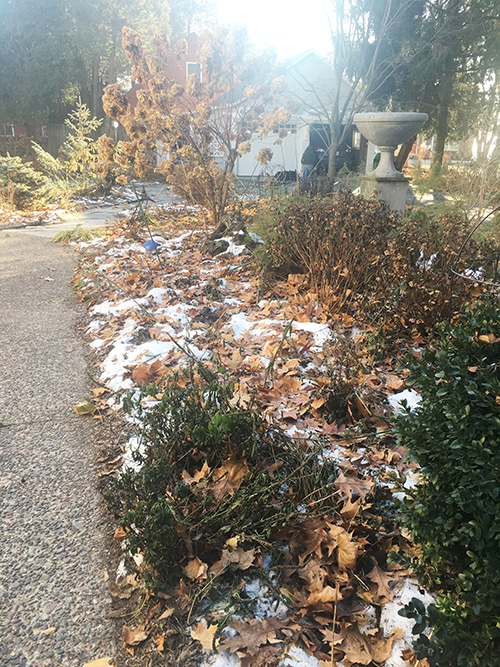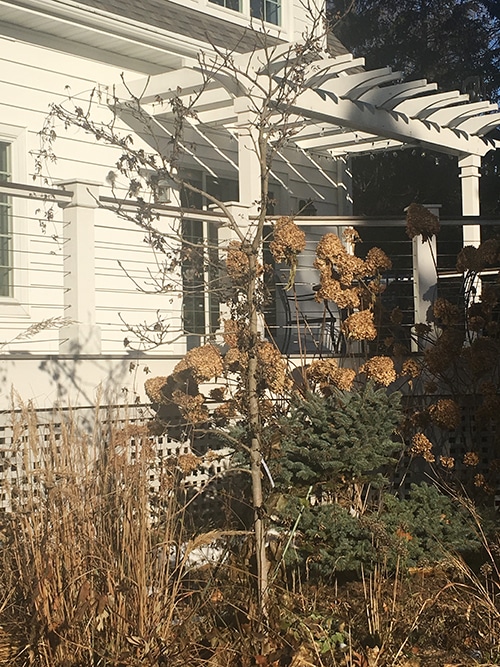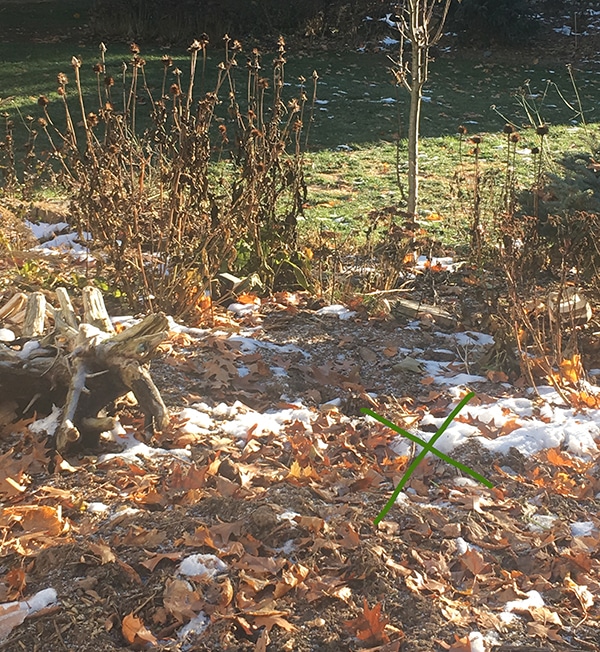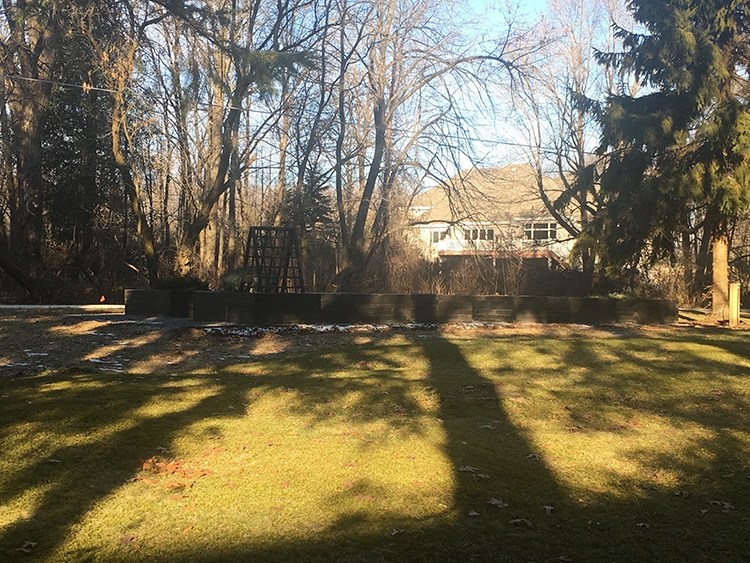Well, it’s time to think about next year’s garden.
I can hear what you’re thinking: But Erin, you haven’t even finished cleaning up this year’s garden! Aren’t you still trying to get a fence up around the vegetable garden this year? Have you even found all the tools you stranded in the garden yet?
And you would be making some very valid points, because the answers to those questions are: You’re right, I haven’t; yes I am; and that is a hopeless cause.
But I would argue that it’s actually a great time to think about next year’s garden. The good and the bad of the gardening season is still fresh in my mind. (Good: dahlia placement, bad: maybe it’s time to stop growing petunias in the ground.) I also have a very realistic view about how much my time, back and budget can take on next year. I’ve found that sense of realism fades rapidly after January.

My pattern has been to take on a bigger gardening project every other year, focusing on keeping up with my growing maintenance load in alternating years. This happens not because it was some kind of grand plan, but rather because I’m just too darn exhausted the year after a big project.
I broke that pattern by redoing the circle garden in 2017 (although I got a head start the previous fall) and then jumping right in to the massive vegetable garden project this year. Which means, I’m due for a more laid-back gardening year in 2019.
So first off, this means that if I go and announce some grand gardening plan in spring, you all need to give me a virtual slap upside the head and tell me to chill out.
But there are areas that need a little bit of help. I never replaced the magnolia in the garden off the deck that died for no apparent reason other than a terrible winter, so that needs to be attended to. I also moved the ‘Orangeola’ maple that’s been a crucial focal point in the garden to a container in late summer so I need to come up with a plan for that area.


I’d also like to rely a little less on annuals in the garden beds. It’s not that I don’t love them, but for things I can’t grow from seed it’s expensive and for the things I can grow from seed it’s a lot of time and space in my modest seed-growing area.
And there are areas I’m still not quite happy with or that have been ignored a bit and in need of a little TLC.
There is one little area weighing on my brain. The vegetable garden, which is on the other side of the small creek that runs through our yard dividing the cultivated from the unmanaged, feels a little disjointed from the rest of the garden. That may be OK or it may drive me nuts; I won’t know until I spend a summer walking to it. There is a part of me that things I’ll need to create a small garden on the way to the veg garden that will help tie it in to the larger landscape.

But that’s not happening next year. Period. Well, probably. I mean, I don’t think it will.
Are you thinking about next year’s garden already?

11 Responses
I have spent the last years designing and planting a mixed hedge with perennials and self-seeding annuals underneath. It has been a massive amount of work but, other than one hole where a tree died, it’s complete. I really want to spend a year just basically watching it grow and helping the understory along. I am never super successful at this, but I want to step back and let the garden just solidify itself for a year and just keep the rest of the yard tidy.
Love your blog and yes, I’m absolutely already thinking about next year’s garden. Like you, I alternate “easy” years with more challenging ones. Next year is going to be a challenging one: For one thing, our driveway is being sorely impacted by tree roots. And before we can fix it, we need to address the tree. The tree–a tulip poplar–is an important part of the landscape, but we made a mistake planing a forest tree in our suburban front yard. So there’s the ripple effect of losing a giant tree from the landscape, redoing a long driveway, and redoing all of the edging along the driveway planting beds, as well. Like I said, challenging. 😉
If that area gets mossy then a brick path will get slippery and be a danger when you are loaded with veggies or tools or whatever. If it’s woodsy area then think about a wood chip or pine needle path which are much less maintenance. And make this path wide which will be a design element that doesn’t need work once you put it in (more or less). That area is not deer-proofed right? So I would be careful about planting too much. In my garden I am trying not to think about new project this coming year, just finishing what’s not done. Hoping i can get through the winter without ordering too much online — esp. as I redid things late in the season and won’t know what made it until spring. I feel like I order things with delusions about how much space I have, let alone empty space.!
What a lovely garden! I also added a garden path last year, as mentioned by the previous post. It is still in progress, but I’m so happy with the addition so far.
As for the area where you lost maple … have you considered a smaller or slower growing conifer as a specimen plant in that area? There’s so many interesting conifers available to choose from. Thanks for your blog—you provide me with lots of inspiration.
Oh my gosh, another fabulous idea. I very much like the idea of a small conifer there and there are so many wonderful ones. The wheels are turning now! Thank you!
I agree with the previous response. I think a path is just what you need to tie your garden to the rest of your yard. We redesigned our landscaping a couple years ago and added pavers as links between spaces. What a difference they made. We didn’t even need to add more beds, which equate to more work; the stepping stones were enough to make difference areas feel connected. They make you want to take a walk to see what is out there. Adding a bench by your raised beds would also be a nice touch, serving as a destination to your stroll.
I would suggest you looking at a Sargent Crabapple for your focal point replacing the maple and also possibly the magnolia. We planted one as a focal point in a bed near our patio and kitchen window and it is terrific. The best part is how the birds use it. We hang an oriole feeder near it and they use it all summer. Sometimes we have as many as 6 oriole in the Sargent Crabapple at once! We located a birdbath in the same bed and the birds seem to love having a little tree to perch in. Sargent Crabapple only get about 6′ tall so they fit in many spots, have pretty flowers in spring and an interesting shape in winter.
As we get older, we continue to look for more ways to reduce the work in our yard, while still having a attractive one we can enjoy. I found it interesting that you are considering giving up on petunias planted in the ground. I am doing the same thing. The ones I plant in pots always do much better. I’m thinking of placing my pots in the ground – or on the ground – where I want petunias. If the pots are attractive they add another level of interest to the bed. The majority of my plants are perennials; I have much better luck with them. The important thing when selecting them is choosing the right plant for where it will be planted, based on amount of sun it will get, how big it will get, etc. I tend to stay away for the ones that take over a bed and ruin my garden plan.
Oh my gosh, so many great ideas here. Thank you! I hadn’t thought about a crab apple there, but why not? It might be perfect, and I love the idea of something bird friendly because the canopy of a small tree is about level with the deck there.
I’m definitely trying to incorporate more shrubs and easy-care perennials in my garden. That’s not to say I don’t sometimes fall for a diva plant, but I try to keep those to a minimum.
As an “old” gardener, I will warn–be careful what you plant. It gets harder and harder to keep the garden up as you age and the deer population multiplied in the 40 years we had our garden at our old home. At our new home I am still gardening, but keeping things much simpler. I know what the deer like, so I don’t plant their favorites. Also, I have found some of the Proven Winners new shrub introductions to be great in the garden. Perennials need to be divided or replaced to look fresh. I still plant perennials, but not ones that need staked or replaced so often. I found over the years that the soil that was really improved was the easiest garden area to take care of. The plants thrived and the soil did not dry out so fast. Also, in this new garden I have been planted small varieties of plants. I want to keep pruning at a minimum. Reseeders are nice to plant too. Larkspur, cleome, impatiens, and forget-me-nots all reseed easily.
You are SO right. I very much appreciate some of the breeding that’s happening to make very small shrubs. These can act almost like perennials except they need even less attention. Great suggestions, thank you!
I think you have created a monster. I pleasant one yet… With your veggies way out there you will need a path to draw you out there. Then along that path will have to be some plantings to make the walk pleasant. Maybe a bench so you can sit there close and contemplate all you are going to plant along that path… This all sounds like fun to me. Along about January 14th you will be ready for a good project.
In my garden the new fence has given me the willies. I don’t like it. Too late now, what was I thinking. I will be planting more and more shrubs to hide said fence.
I absolutely have created a monster, but I can’t help myself! A path is a very good idea and Lord knows I love a good garden path. Plus moss grows plentifully in part of this area so I’m picturing rustic mossy brick.
You’ve got me worried about the fence! What don’t you like about yours? Mine is due to have the posts set next week so if I need to change my plan I better speak up now!